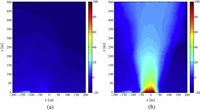Volcanic plume vent conditions retrieved from infrared images: A forward and inverse modeling approach
Cerminara M., T. Esposti Ongaro, S. Valade, A.J.L. Harris (2015).
Journal of Volcanology and Geothermal Research, Volume 300, Pages 129-147, doi:10.1016/j.jvolgeores.2014.12.015.
Abstract
We present a coupled fluid-dynamic and electromagnetic model for volcanic ash plumes. In a forward approach, the model is able to simulate the plume dynamics from prescribed input flow conditions and generate the corresponding synthetic thermal infrared (TIR) image, allowing a comparison with field-based observations. An inversion procedure is then developed to retrieve vent conditions from TIR images, and to independently estimate the mass eruption rate. The adopted fluid-dynamic model is based on a one-dimensional, stationary description of a self-similar turbulent plume, for which an asymptotic analytical solution is obtained. The electromagnetic emission/absorption model is based on Schwarzschild’s equation and on Mie’s theory for disperse particles, and we assume that particles are coarser than the radiation wavelength (about 10 μm) and that scattering is negligible. In the inversion procedure, model parameter space is sampled to find the optimal set of input conditions which minimizes the difference between the experimental and the synthetic image. Application of the inversion procedure to an ash plume at Santiaguito (Santa Maria volcano, Guatemala) has allowed us to retrieve the main plume input parameters, namely mass flow rate, initial radius, velocity, temperature, gas mass ratio, entrainment coefficient and their related uncertainty. Moreover, by coupling with the electromagnetic model we have been able to obtain a reliable estimate of the equivalent Sauter diameter of the total particle size distribution. The presented method is general and, in principle, can be applied to the spatial distribution of particle concentration and temperature obtained by any fluid-dynamic model, either integral or multidimensional, stationary or time-dependent, single or multiphase. The method discussed here is fast and robust, thus indicating potential for applications to real-time estimation of ash mass flux and particle size distribution, which is crucial for model-based forecasts of the volcanic ash dispersal process.
http://www.sciencedirect.com/science/article/pii/S0377027314003965


